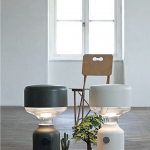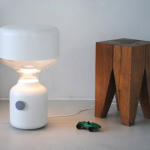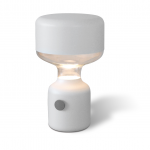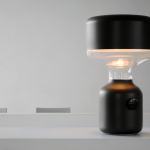Around 1920, the Jugendstil (Art Nouveau) movement linked lamp bases modelled on plants with lampshades in coloured Tiffany glass. In the 1980s, the Memphis Group created spectacular Pop-Art objects which hardly resembled lamps at all. The design of the Jinn floor light and table light questions the classical combination of the base and shade. Jinn defines a table and floor lamp as a formal unity. It is as if it was from one mould and its form language is well balanced. Jinn attracts attention to itself through this cohesive form as well as the innovative lighting concept. As the central portion glows and light appears to be “trapped” within it, one is led to think of a lamp from the Fairy Tales from the 1001 Nights. In traditional lamps, a central stem supports the lamp shade. However, in Jinn, a glass element acts as a link between the base and the shade. The light source is on the floor of the base of the lamp. Light is reflected by the aluminum shade and is emitted through the glass. The adjustment of this floor and table lamp makes a further association with the Genie of the Lamp from the Fairy Tales from the 1001 Nights. Just as in traditional oil or gas lamps, the control is on the curved base of this lamp. A circular rotary switch enables the user intuitively to alter the strength of the light.
producer: vertigo bird
designer: mathias hahn
material: metal
period: 2011
award: red dot 2012






